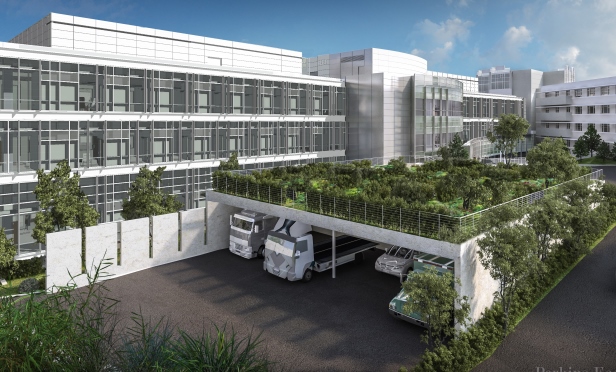 Ultimately, the best value solution evolved into a progressive design-build delivery method.
Ultimately, the best value solution evolved into a progressive design-build delivery method.
GREENBRAE, CA—The Marin General Hospital replacement project originally started out using a traditional design-bid-build model, but later converted to progressive design-build/PDB after the team was challenged by the owner to customize a solution to the unique risks, constraints and value preferences. Ultimately, the best value solution evolved into one that personifies the positive characteristics of a progressive design-build delivery method and overcame the contractual challenges of changing the delivery method mid-stream. In this exclusive, Simon Gregson, vice president of healthcare for McCarthy Building Companies Inc.'s Northern Pacific region, recently shared some insights into the progressive design-build process, how it differs from traditional methods, the value of PDB to the healthcare industry and how it helped elevate the Marin General Hospital replacement project.
GlobeSt.com: What is progressive design-build?
Gregson: The progressive in PDB infers an improvement, even tinkering, of the design-build delivery method. It also can imply a customization of the wants and needs of project owners and their risk management approach. In a PBD relationship, the owner will enter into a contract with one entity, the design builder, at some point and the big question is when? The timing of the risk transfer from owner to design-builder has significant implications on cost, schedule, quality and ability to influence design. But most importantly of all, is how this timing will influence the behavior, performance and ultimately the results of the entire project team.
GlobeSt.com: How does PDB differ from a traditional design-build delivery method?
Gregson: Although there are a wide range of options as to when to procure the design-builder, a traditional approach would typically see the owner bring on board the design-builder at 20% design completion–early enough to get a price lock–but not too late to transfer the design risk. Occasionally, the results will be disappointing with owners experiencing inefficient design solutions due to the lack of constructability and economic acumen from key trade subcontractors at the very onset of the design phase and incomplete design elements priced with uncertain (inflated) risk premiums.
With a PDB solution, owners enjoy the best of both worlds as they engage with their designer and builder early in the process to take full advantage of their expertise. Owners can hire both teams independently and then fuse them together later as a single design-build entity, or go ahead and select a design-build team right at the beginning. Either way, the combined design-build entity will collaborate as one single enterprise with the goal to optimize value throughout the life cycle of the project.
GlobeSt.com: What is the value to owners and why would a healthcare project owner choose PDB?
Gregson: Rather than requesting the design-builders to provide price, schedule and performance commitments from the outset, owners can defer these items until after the design has been adequately defined. Transferring the design and procurement risks at the appropriate time will reduce the amount of risk premiums/cost, heighten the opportunity for collaboration, teamwork and improve project outcomes.
Furthermore, PDB is a strong fit for the healthcare industry because it facilitates a fast-track schedule approach. As an example, many California healthcare owners are motivated to treat patients as soon as possible and take advantage of the office of statewide health planning and development's incremental or collaborative permit review initiatives. The design-build entity can phase the construction of certain work packages while design is being completed and permitted, and realize significant schedule savings.
GlobeSt.com: Can you share examples of how PDB has helped elevate the Marin General Hospital replacement project?
Gregson: The Marin General Hospital project started as a traditional design-bid-build with McCarthy Building Companies as the general contractor and Perkins Eastman as the architects. The teams worked collaboratively through the design development phase, but recognized that there were even greater opportunities to optimize value.
Marin General Hospital challenged McCarthy to customize a revised delivery approach that addressed the unique risks, constraints and value preferences of the client, including the operational requirement of treating first patients by summer of 2020. To address these challenges, the team's solution ultimately evolved into an approach that personified the positive characteristics of a progressive design-build delivery method.
The implementation of an incremental guaranteed maximum price procurement strategy supported the fast-track schedule as well as maintained focus on cost certainty. The team was able to engage key trade subcontractors early in the design process and, together with the design professionals, collectively address the building information model/BIM challenge of how and when to apply the appropriate amount of resources during the design phase of the project to give a predictable cost and schedule outcome. The design-build team utilized the benefit of progressive design-build to save time by commencing construction as the design, permitting and procurement phases remained active, all while preserving cost and schedule certainty.
The PDB delivery method creates the ideal environment to successfully navigate the pros and cons of the phased procurement and construction approach, while also serving as a catalyst for project innovation. The outcome becomes more art than science, with McCarthy playing the role as conductor to the symphony of BIM coordination in OSPHPD C-minor.
© Touchpoint Markets, All Rights Reserved. Request academic re-use from www.copyright.com. All other uses, submit a request to [email protected]. For more inforrmation visit Asset & Logo Licensing.







